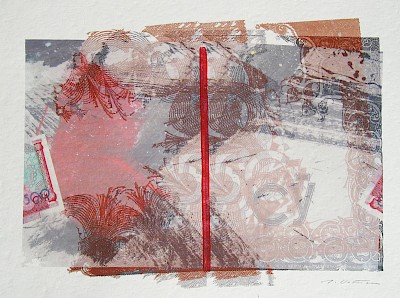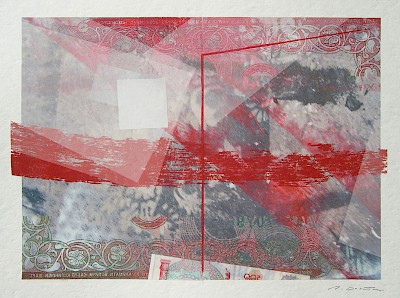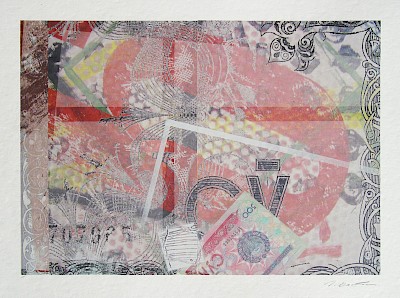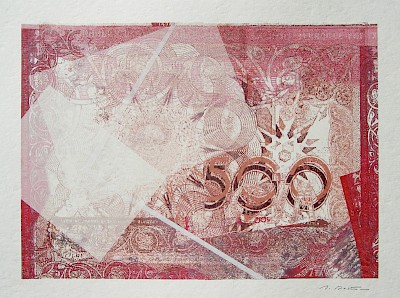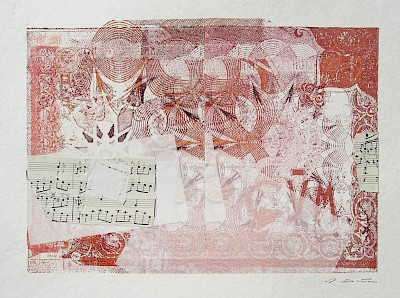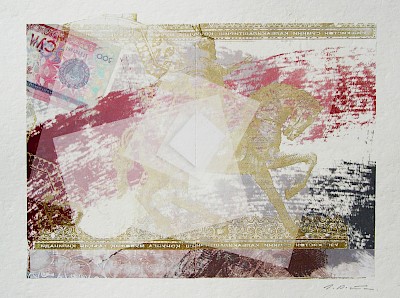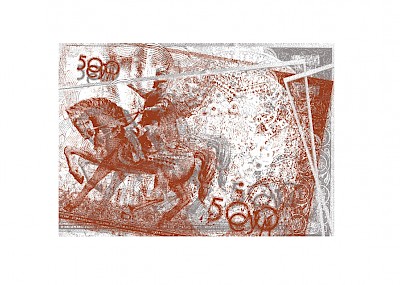Presentations
J. Doña: The Sum ProjectNovember 2013–February 2014
Text by Yolanda Ochando
In November 2011 I visited Uzbekistan, a country that greatly surprised me because of its important heritage. In fact, UNESCO has declared some of its cities as World Heritage Sites.
At the end of the trip I found in my wallet some bank notes left. They are worth nothing because the local currency, called Sum, is not available outside Uzbekistan.
Usually I just throw these type of notes away, but on this occasion I guessed they could have an artistic use and immediately I thought I should give them to Jose Doña, as I did. My proposal —The SUM PROJECT— involved an absolute freedom in terms of technique, size, etc. The only requirement was that the notes should appear somehow in the works.
Why did I link the Sums with Jose? It was almost an automatic act. I remembered an image of his workshop, with enormous pieces of cardboard on the floor, waiting to be trodden on by visitors. Later on they would be on the easel from where conveniently treated and worked on they would be exhibited in an art gallery. I also linked Sums and Jose because he uses collage in paintings and prints too. That versatility in the use of different materials and in mixing techniques and his mastery in traditional silkscreen makes me think of him as well.
The SUM PROJECT includes six collages and one silkscreen —in a limited edition of 15— it is an outstanding example of these characteristics. At the same time it shows —as the artist himself admits— that his work is always influenced by personal and external events and, for that reason, they are a reflection of his present time.
Last but not least, I would like to point out the concept of art that Jose Doña has. He considers that any citizen has the right to consume dignified art, no matter his economic situation. He says “The creation of art is not a heritage for the arty people or for those who can afford it. Art belongs to those who observe it and enjoy their sensations.”
Text by J. Doña
The possibility of knowing first hand about the hidden regions of Uzbekistan, its people, customs, culture, landscape and aromas, would allow me to work in this project not only from that experience but also with direct sensations provoked by personal experiences that would be stuck in mind and retina.
However, the work I have done, although it has been based on that theme, has a completely different point of view from that possibility, because I never visited that region and the information I have is rare or even nil.
Taking advantage of this lack of information I try to make an oneiric work in which I idealize the sensations this remote region of our planet instills in me. The challenge is an approximation even the very ignorance.
By the hand of Yolanda Ochando comes the idea of proposing to me an exhibition with works inspired by that secret place, using as information some bank notes from that country, all of them full of details that symbolize its atmosphere. With these notes I have wanted to make my works, trying not to use any other information.
So I take the proposition enthusiastically and I decide to not see anything about this country. It is a real challenge not getting more information, not reading, not listening to anything related to this place, despite appearances my curiosity is enormous.
However this determination has allowed me to work without contaminations and false reality. The idea is to focus on making my work only with the immediate reference I get, without taking into consideration anything else.
I decide to focus on the symbols that are printed on these bank notes. Through them I perceive an unknown and very interesting atmosphere, different from what we know and full of that mysticism that characterizes hidden regions. The result is six collages and one silkscreen in a limited edition of 15. The collages are done with mix technique on thick Bristol board.
En noviembre de 2011 visité Uzbekistán, un país que me sorprendió gratamente por su enorme riqueza histórica, así reconocida por la UNESCO que ha declarado Patrimonio de la Humanidad a alguna de sus ciudades.
Al regreso del viaje encontré en mi monedero algunos billetes que me habían sobrado. No tenían valor alguno porque la moneda local, llamada sum, no cotiza más allá de las fronteras uzbekas.
Normalmente me deshago de ese tipo de billetes, pero en esta ocasión me parecieron que podrían tener un uso artístico e inmediatamente pensé en entregárselos a Jose Doña, como así hice. Mi propuesta — que evidentemente pasó a llamarse PROYECTO SUM — implicaba completa libertad en cuanto a técnica, formato, etc. El único requisito era que los billetes apareciesen de alguna manera en las obras.
¿Por qué relacioné los sums con Jose? Fue casi un acto automático. A mi mente vino una imagen de su estudio, con unos enormes cartones tirados en el suelo esperando a ser pisados por los visitantes, para luego pasar a un caballete y de ahí — debidamente tratados e intervenidos — a una galería de arte.
También porque Jose utiliza el collage tanto en sus pinturas como en sus grabados. Esa versatilidad suya en el uso de materiales y en la mezcla de técnicas, así como su maestría con la serigrafía, en su vertiente más artesanal, me hicieron pensar en él.
Estas obras que conforman el PROYECTO SUM — seis collages y una serigrafía en limitada edición del 15 ejemplares — son un magnífico ejemplo de estas características. Al mismo tiempo reflejan — tal y como reconoce el artista — que su obra está siempre marcada necesariamente por acontecimientos personales y externos y, por lo tanto, son un reflejo de su presente.
Por último, me gustaría destacar el concepto que del arte tiene Jose Doña cunado considera que los ciudadanos tienen derecho a consumir un arte digno, independientemente de su poder adquisitivo y de la situación económica del entorno. Textualmente nos dice: El arte creado no es patrimonio de los entendidos o de los que pueden permitírselo, el arte pertenece irreversiblemente al que lo observa y se beneficia de sus sensaciones
.
El poder conocer de primera mano las regiones recónditas de Uzbekistán, sus gentes, las costumbres, su cultura, los paisajes y los aromas, permitirían sin duda haber trabajado no sólo desde el conocimiento de la realidad, sino también con las diversas sensaciones directas, surgidas de vivencias que quedarían adheridas en la mente y la retina. Sin embargo, la base del trabajo que he realizado, aun estando fundamentado en la misma temática, tiene un enfoque bien diferenciado con respecto al planteamiento anterior, ya que nunca visité dichas regiones y la información que personalmente de ellas dispongo es escasa por no decir prácticamente nula. Aprovechando este vacío informativo trato de realizar un trabajo onírico en el que idealizo por medio de grafismos las sensaciones que me sugieren esta remota región de nuestro planeta. El reto planteado, es finalmente la aproximación pese al desconocimiento.
De la mano de Yolanda Ochando, parte la idea de proponerme una exposición con obras basadas en aquel recóndito lugar, utilizando como material informativo unos cuantos billetes de banco de dicho país, repletos todos ellos, de detalles que simbolizan toda su atmósfera. En base a esto, he querido realizar mis obras, pretendiendo no utilizar ni disponer de ninguna otra información.
Así pues tomo la idea con entusiasmo y me planteo no ver absolutamente nada sobre ello por ningún medio. No informarme, no leer ni escuchar nada relativo sobre el lugar ha supuesto para mí un verdadero reto, ya que por el contrario de lo que pueda parecer mi curiosidad e inquietudes son infinitas!, sin embargo, esta determinación me ha permitido trabajar sin contaminantes ni falsas realidades. La idea se centra en realizar con tan sólo la inmediata referencia adquirida, sin tener en cuenta mucho más allá de lo tangible. En base a esto decido centrarme exclusivamente en los simbolismos que están impresos en dichos billetes de banco. A través de ellos percibo un ambiente desconocido y muy interesante, muy diferente a lo habitualmente conocido culturalmente hablando e impregnado de ese misticismo que caracteriza a todas las regiones recónditas.
El resultado final lo componen una serie de 6 obras originales más una serigrafía en tirada muy limitada de tan solo 15 ejemplares numerados. Los originales están realizados en técnica mixta y muy diversa, en ellos se ha empleado la serigrafía, transferibles, collage y diferentes intervenciones directas sobre cartulina de gran gramaje.
← previous (10/19)
III Festival Miradas de Mujeres 2014. Fátima Conesa: Labyrinth next (12/19) →
II Festival Miradas de Mujeres 2013. Natalia Latorre

